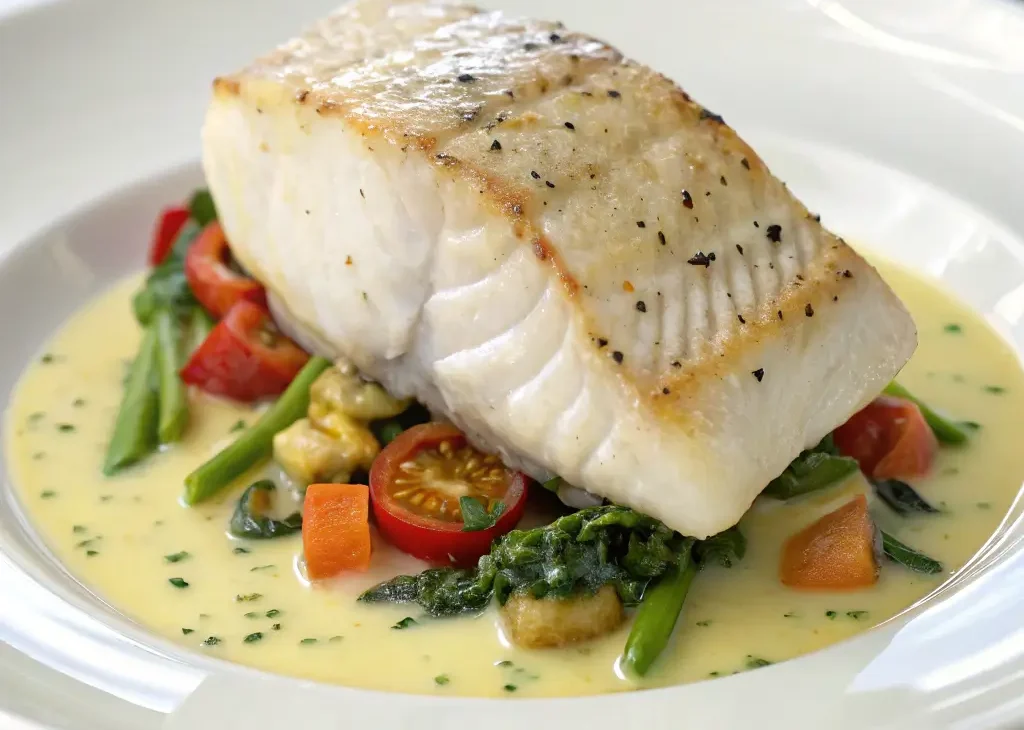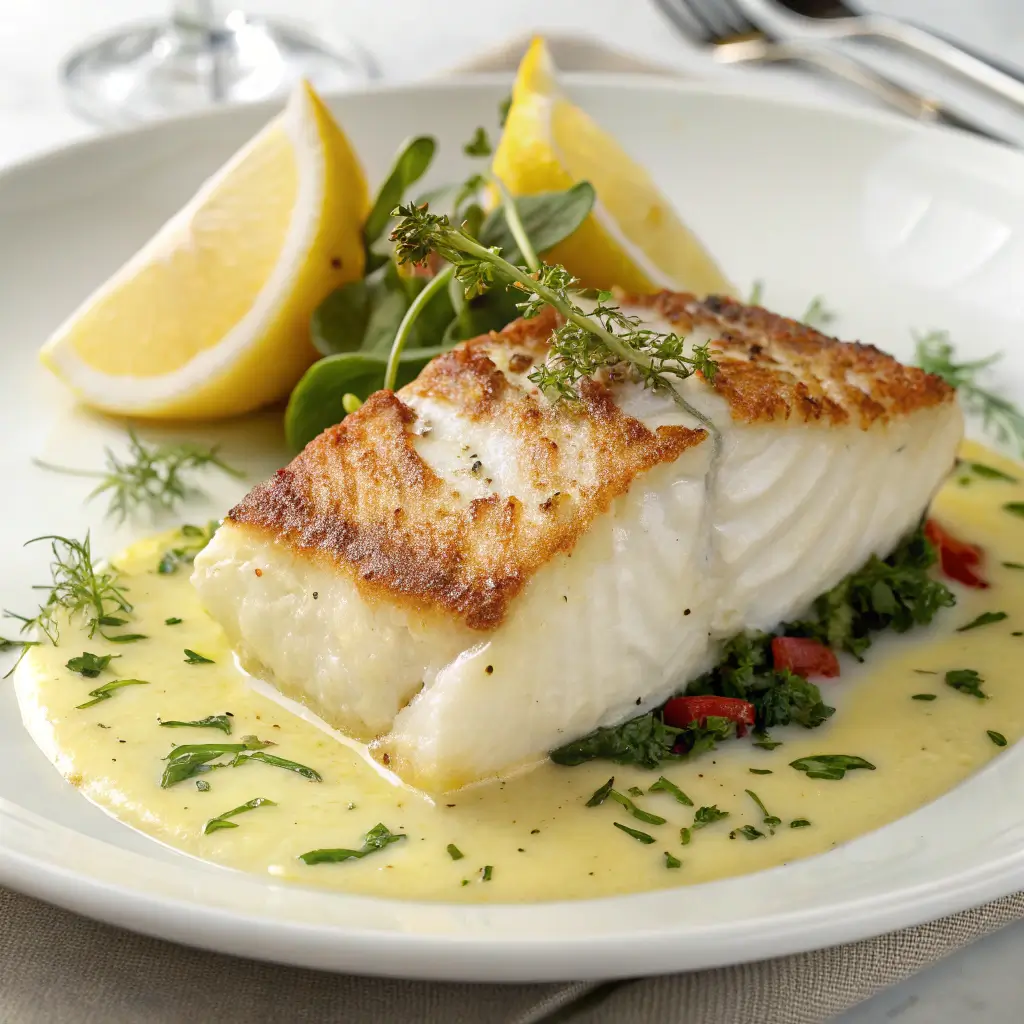Healthy Halibut with Classic Beurre Blanc
Light, luxurious, and surprisingly simple—this halibut with beurre blanc (butter-white sauce) brings restaurant-grade refinement into your kitchen without fuss. Paired with a few smart techniques and thoughtful tips, it yields a memorable dish in under 35 minutes, perfect for evening gatherings or a midweek upgrade.
Why You’ll Love This Dish
- Gourmet finish at home. A silken, tangy butter sauce gives you that restaurant-grade elegance with minimal effort.
- Quick and efficient. From prep to plate: 35 minutes tops.
- Frugal shopping list. Less than ten accessible ingredients and most are pantry staples.
- Flexible & forgiving. Use alternate white fish or swap herbs to match your pantry.
- Eye-catching presentation. Glossy pale fish crowned in sauce and herbs—no extra plating skills needed.

Choosing the Best Halibut
Look for fillets or cheeks with a clean, pearly-white hue and an ocean-fresh scent—never fishy. If frozen, thaw in your fridge overnight and pat very dry to ensure ideal browning. Like halibut isn’t available? Thick cuts of cod, sea bass, or grouper are excellent substitutes so long as they’re firm enough not to fall apart during searing.
Ingredients (Serves 4)
- 4 halibut fillets or cheeks, 150–200 g (5–7 oz) each
- 1 tbsp neutral oil (grape seed, canola, etc.)
For the Beurre Blanc:
- 1 tbsp minced shallot (or mild onion)
- 2 tbsp fresh lemon juice
- 1 tbsp white grape juice (or unsweetened), plus 1 tbsp apple cider vinegar
- 8 tbsp cold unsalted butter (about 110 g / 4 oz), diced
- Sea salt, to taste
- A pinch of white pepper
- 1 tbsp finely chopped fresh dill (or parsley, tarragon)
- Lemon slices or wedges, for garnish
Pro Tip: Use cold butter and a low heat to avoid sauce separation—this is the key to a shiny, stable sauce!
Alternatives & Variations
- Shallots swap: Replace with fine diced onion + ¼ garlic clove for depth.
- Oils: Use mild canola or vegetable oil—but skip extra-virgin olive—it can overpower subtle flavors.
- Herbs: Dill is ideal, but parsley or tarragon work—just adjust the amount if flavor is strong.
Common Pitfalls & How to Avoid Them
- Curdled sauce: Add butter slowly over low heat and whisk continuously.
- Overcooked fish: Watch edges—when they go opaque halfway up, flip and cook only 1–2 more minutes.
- Oil too hot: Aim for medium-high; flick water in—if it evaporates in ~2 seconds, you’re set.
- Wet fish: Dry thoroughly before cooking—moisture hinders browning and leads to steaming.
Step-by-Step Preparation
1. Flavor Base
- In a small saucepan, combine shallots, lemon juice, grape juice, and vinegar. Simmer until reduced to about ¼ the original volume—this concentrates the citrus-shallot flavor.
2. Emulsify the Butter
- Lower heat to low. Add cold butter cubes one at a time, whisking between each until fully melted and emulsified before adding the next. Continue until the sauce is smooth, glossy, and thickened. Season with salt, white pepper, and more lemon if needed. Keep warm off direct flame, stirring occasionally to maintain consistency.
3. Cook the Halibut
- While the sauce simmers, heat a heavy skillet over medium-high. Add oil and let heat well. Place the fish, presentation side down first. Sear undisturbed for 3–4 minutes to develop a golden crust, then flip and cook just another 1–2 minutes until opaque. Finish with a squeeze of lemon for brightness.
4. Final Touches
- Remove sauce from heat, stir in dill (or your herb). This adds freshness and balances the rich butter flavor.
5. Serve with Flair
- Place halibut on warmed dinner plates. Spoon beurre blanc over or around the fillets. Garnish with herb sprigs and lemon wedges.
Suggested Side Dishes
- Basmati rice with scallions – absorbs the sauce beautifully.
- Roasted baby potatoes in skin – crisp contrast to delicate fish.
- Steamed asparagus – fresh green color and snap.
- Arugula salad with avocado and lemon dressing – adds crunch and cleansing acidity.
Storage & Reheat Tips
- Refrigerate sauce and fish separately in sealed containers, up to 2 days.
- Reheat fish gently in a covered skillet with a splash of water, low heat, 3 minutes.
- Warm sauce over very low heat, whisk until fluid and warmed—do not boil to prevent separation.
- Prep ahead: Sauce can be made and held warm in a thermal carafe, then whisked before serving. Cook fish last so it’s fresh and tender.
Approximate Nutrition (per serving)
- Calories: 160–180
- Protein: 30–35 g
- Total Fat: 8–10 g
- Carbs: < 5 g
(These figures include only fish and sauce, without sides.)
Chef’s Tips to Elevate This Dish
- Use an instant-read thermometer. 52–54 °C (125–130 °F) in the thickest part creates moist, tender fish.
- High-fat European-style butter (82% fat) renders a silkier sauce with better shine.
- Strain the sauce before adding herbs for a refined, restaurant-quality finish.
- Chill your butter cubes beforehand (about 10 minutes) if your kitchen is warm—to maintain good emulsion control.

Putting It All Together
Imagine slicing through a crisp golden crust to reveal tender, moist halibut beneath, all bathed in a buttery, tangy sauce. Each mouthful brims with balanced richness and freshness—proof that high-end dining can easily be done at home. Serve this elegant dish once and it’s destined to become a weeknight favorite and a go-to for impressing guests.
Enjoy every bite—and if you discover any creative tweaks, share them! You might just inspire someone else to bring something special to their table.

